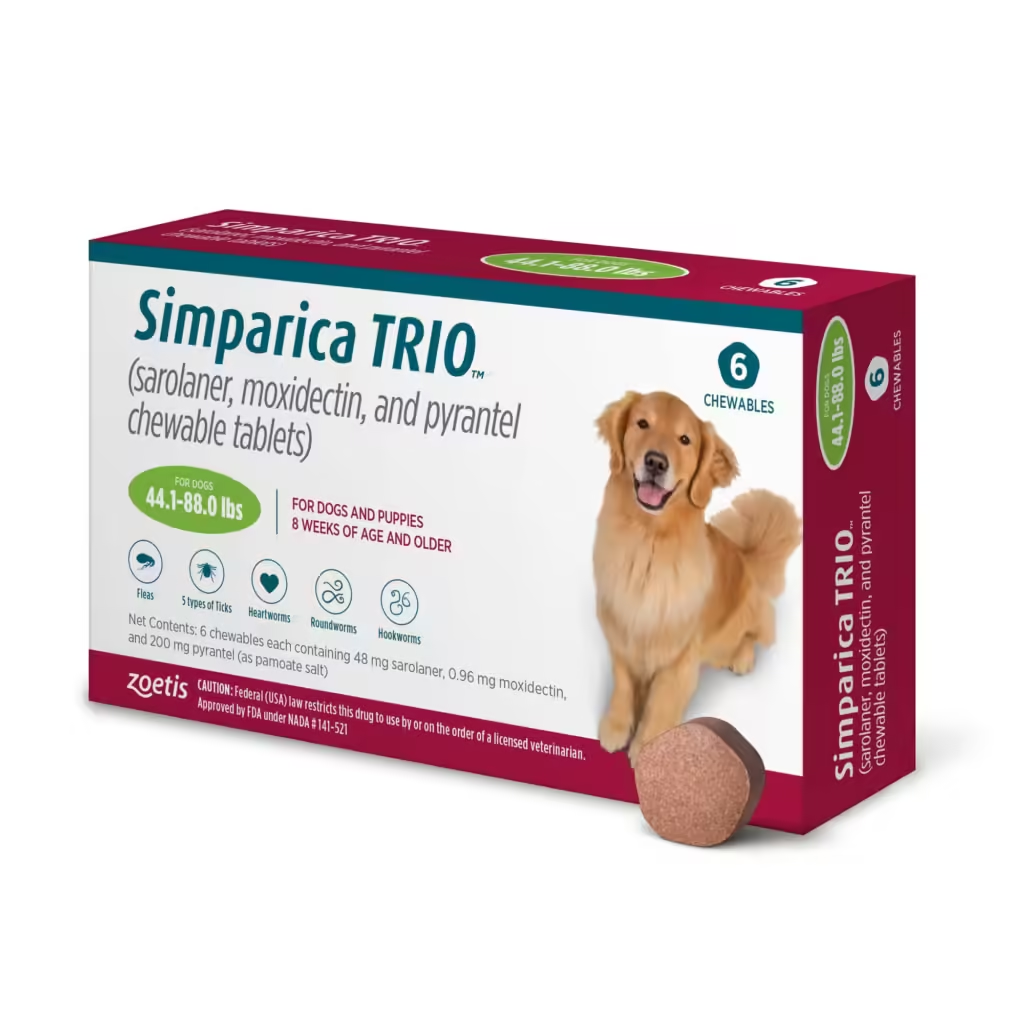Simparica Trio is a revolutionary veterinary medicine designed to protect dogs from a range of harmful parasites. Combining three active ingredients—sarolaner, moxidectin, and pyrantel—this medication offers broad-spectrum protection against fleas, ticks, heartworms, and intestinal worms. This comprehensive guide explores the science behind Simparica Trio, its benefits, potential side effects, and best practices for use. We will also delve into the history of parasitic treatments for pets, the development of Simparica Trio, and its impact on modern veterinary medicine.
The History of Parasitic Treatments for Pets
Early Treatments and Challenges
The battle against parasites in pets has a long history. In the early days of veterinary medicine, treatments were often rudimentary and sometimes dangerous. Early antiparasitic treatments included the use of natural remedies such as garlic, vinegar, and various herbs. While some of these methods had limited effectiveness, they often lacked the potency required to fully eliminate infestations.
Advances in Veterinary Medicine
The 20th century brought significant advancements in veterinary medicine. The development of chemical treatments, such as organophosphates and pyrethroids, marked a new era in parasite control. These compounds were more effective but often came with their own set of risks, including potential toxicity to pets and humans. As research progressed, safer and more targeted treatments were developed, leading to the introduction of modern antiparasitics.
The Need for Combination Treatments
As understanding of parasitic life cycles and resistance patterns grew, the need for combination treatments became apparent. Single-agent treatments were often insufficient to address the full spectrum of parasitic threats, leading to the development of multi-functional medications like Simparica’s Trio. By combining multiple active ingredients, these treatments offer a more comprehensive approach to parasite control.
The Science Behind Simparica Trio
Active Ingredients and Their Functions
Simparica’s Trio is composed of three active ingredients: sarolaner, moxidectin, and pyrantel. Each of these components targets different types of parasites, providing a broad spectrum of protection.
- Sarolaner: This is an isoxazoline class compound that targets the nervous systems of fleas and ticks, causing paralysis and death. It is effective against various tick species, including the American dog tick, black-legged tick, and Gulf Coast tick.
- Moxidectin: Moxidectin is a macrocyclic lactone that interferes with neurotransmission in heartworms and certain intestinal worms. It is particularly effective in preventing heartworm disease by killing the larvae before they mature into adult worms.
- Pyrantel: This is an anthelmintic that works by causing paralysis in intestinal worms, such as roundworms and hookworms, allowing them to be expelled from the body through natural processes.
Mechanism of Action
The combination of these three active ingredients allows Simparica’s Trio to target different parasites through distinct mechanisms of action. Sarolaner disrupts the central nervous system of fleas and ticks by blocking GABA and glutamate-gated chloride channels, leading to uncontrolled nervous system activity and death. Moxidectin enhances the release of gamma-aminobutyric acid (GABA) at the neuromuscular junction, causing paralysis and death of heartworm larvae and certain intestinal worms. Pyrantel, on the other hand, acts as a depolarizing neuromuscular blocking agent, leading to spastic paralysis of the intestinal worms, which are then expelled by the host’s digestive system.
Pharmacokinetics
Understanding the pharmacokinetics of Simparica’s Trio is essential for appreciating its efficacy and safety. Once administered orally, sarolaner is rapidly absorbed into the bloodstream, reaching peak plasma concentrations within a few hours. Moxidectin is also absorbed quickly and distributed throughout the body, with a longer half-life that allows for sustained protection against heartworms. Pyrantel has a more localized effect in the gastrointestinal tract, minimizing systemic exposure and potential side effects.
Benefits of Simparica Trio
Comprehensive Protection
One of the primary benefits of Simparica’s Trio is its comprehensive protection against multiple types of parasites. By addressing fleas, ticks, heartworms, and intestinal worms, this medication simplifies the process of parasite prevention for pet owners. Instead of administering multiple products, pet owners can rely on a single, convenient treatment.
Efficacy
Clinical studies have demonstrated the high efficacy of Simparica’s Trio in controlling and preventing parasitic infestations. In controlled trials, sarolaner provided 100% efficacy against fleas within 8 hours and sustained this level of protection for a full month. Moxidectin has been shown to effectively prevent heartworm disease when administered monthly, while pyrantel effectively eliminates common intestinal worms.
Convenience
Simparica’s Trio is administered once a month as a flavored chewable tablet, making it easy for pet owners to incorporate into their routine. The palatable formulation encourages compliance, ensuring that pets receive consistent protection.
Safety Profile
The safety profile of Simparica’s Trio has been thoroughly evaluated in clinical trials. The medication is well-tolerated by most dogs, with a low incidence of adverse effects. Common side effects, when they do occur, are typically mild and transient, including symptoms such as vomiting, diarrhea, and lethargy.
Potential Side Effects and Considerations
Common Side Effects
While Simparica’s Trio is generally safe, some dogs may experience side effects. The most commonly reported adverse reactions include:
- Vomiting
- Diarrhea
- Lethargy
- Anorexia (loss of appetite)
These side effects are usually mild and resolve on their own without the need for medical intervention.
Rare Side Effects
In rare cases, more serious side effects may occur. These can include:
- Neurological symptoms such as tremors, ataxia (loss of coordination), and seizures
- Allergic reactions, including itching, swelling, and hives
Pet owners should monitor their dogs closely after administering Simparica Trio and consult a veterinarian if they observe any concerning symptoms.
Precautions
Certain precautions should be taken when using Simparica’s Trio. The medication is intended for use in dogs only and should not be used in cats or other animals. Additionally, it is important to follow the recommended dosage guidelines based on the dog’s weight to avoid potential overdosing. Simparica Trio should not be used in puppies under 8 weeks of age or in dogs weighing less than 2.8 pounds.
Best Practices for Using Simparica Trio
Administration
Simparica’s Trio should be administered once a month, ideally on the same day each month to maintain consistent protection. The chewable tablet can be given with or without food. If the dog vomits within an hour of administration, it is recommended to give another dose to ensure efficacy.
Storage
The medication should be stored at room temperature, away from moisture and direct sunlight. Keeping the tablets in their original packaging until use helps to preserve their potency.
Veterinary Consultation
Before starting Simparica’s Trio, pet owners should consult their veterinarian to ensure it is the appropriate choice for their dog. A veterinarian can provide guidance on the correct dosage and address any concerns about potential interactions with other medications the dog may be taking.
The Development of Simparica Trio
Research and Innovation
The development of Simparica Trio involved extensive research and innovation in the field of veterinary medicine. Zoetis, the company behind Simparica Trio, conducted numerous studies to identify the optimal combination of active ingredients and to evaluate their safety and efficacy.
Clinical Trials
Clinical trials played a crucial role in demonstrating the effectiveness of Simparica Trio. These trials involved testing the medication on a large number of dogs under various conditions to assess its ability to prevent and control parasitic infestations. The results of these trials provided robust evidence supporting the use of Simparica Trio as a broad-spectrum parasiticide.
Regulatory Approval
Obtaining regulatory approval for Simparica Trio required rigorous testing and documentation to meet the standards set by veterinary regulatory agencies. The medication was reviewed for its safety, efficacy, and quality before receiving approval for use in dogs. This process ensures that Simparica Trio meets the highest standards of veterinary care.
The Impact of Simparica Trio on Veterinary Medicine
Simplifying Parasite Prevention
Simparica Trio has had a significant impact on veterinary medicine by simplifying the process of parasite prevention. By combining three active ingredients into a single monthly tablet, it has made it easier for pet owners to protect their dogs from a range of parasites. This convenience has likely contributed to higher compliance rates and better overall health outcomes for pets.
Advancing Multi-Functional Treatments
The success of Simparica Trio has highlighted the benefits of multi-functional treatments in veterinary medicine. It has set a precedent for the development of other combination medications that address multiple health concerns simultaneously. This approach not only improves the efficiency of treatment but also enhances the quality of life for pets by reducing the need for multiple medications.
Raising Awareness of Parasite Prevention
The introduction of Simparica Trio has also raised awareness of the importance of parasite prevention among pet owners. Educating pet owners about the risks posed by fleas, ticks, heartworms, and intestinal worms has encouraged proactive measures to protect pets. This increased awareness has contributed to the overall well-being of pets and has reduced the prevalence of parasitic infestations.
Case Studies and Real-World Applications
Case Study 1: Preventing Flea and Tick Infestations
A study conducted in a veterinary clinic involved 50 dogs with a history of flea and tick infestations. These dogs were administered Simparica Trio monthly for six months. The results showed a significant reduction in flea and tick infestations, with 98% of the dogs remaining parasite-free throughout the study period. Pet owners reported high satisfaction with the ease of administration and the overall effectiveness of the medication.
Case Study 2: Managing Heartworm Prevention
In a heartworm-endemic area, a group of 100 dogs was enrolled in a study to evaluate the efficacy of Simparica Trio in preventing heartworm disease. Over a 12-month period, none of the dogs tested positive for heartworm infection. The study concluded that Simparica Trio provided reliable protection against heartworm disease when administered monthly.
Case Study 3: Addressing Intestinal Worms
A veterinary practice in a rural community faced challenges with intestinal worm infestations in dogs. They implemented a protocol using Simparica Trio for all dogs presenting with symptoms of intestinal worm infestations. Within three months, the prevalence of intestinal worms in the community decreased by 85%. The study highlighted the effectiveness of Simparica Trio in controlling and preventing intestinal worm infestations.
Comparing Simparica Trio to Other Parasiticides
Simparica Trio vs. Traditional Treatments
Traditional parasitic treatments often involve administering separate medications for different types of parasites. This can be cumbersome for pet owners and may result in inconsistent protection. Simparica Trio simplifies this process by providing comprehensive protection in a single monthly dose, improving compliance and overall efficacy.
Simparica Trio vs. Other Combination Treatments
Several other combination treatments are available on the market, but Simparica Trio stands out due to its specific combination of active ingredients. For example, some combination treatments may include different active ingredients that target similar parasites but may vary in their efficacy and safety profiles. Simparica Trio’s formulation has been extensively tested and proven to be highly effective against a broad spectrum of parasites.
Cost and Accessibility
The cost of Simparica Trio may vary depending on the region and the veterinary clinic. While it may be more expensive than some traditional treatments, its comprehensive protection and convenience often justify the price for many pet owners. Additionally, the availability of Simparica Trio through veterinary clinics ensures that pet owners receive professional guidance and support when using the medication.
Conclusion
Simparica Trio represents a significant advancement in the field of veterinary medicine, offering comprehensive protection against a wide range of parasites in a single, convenient monthly dose. Its combination of sarolaner, moxidectin, and pyrantel targets fleas, ticks, heartworms, and intestinal worms through distinct mechanisms of action, ensuring broad-spectrum efficacy. With its proven safety profile, ease of administration, and high efficacy, Simparica Trio has become a preferred choice for many pet owners and veterinarians.
The development and success of Simparica Trio highlight the importance of innovative solutions in parasite prevention. By simplifying the process of parasite control and raising awareness of the risks posed by these pests, Simparica Trio has contributed to the overall well-being of pets and has set a new standard in veterinary care. As research continues and new advancements are made, the future of parasitic treatments for pets looks promising, with Simparica Trio leading the way.







